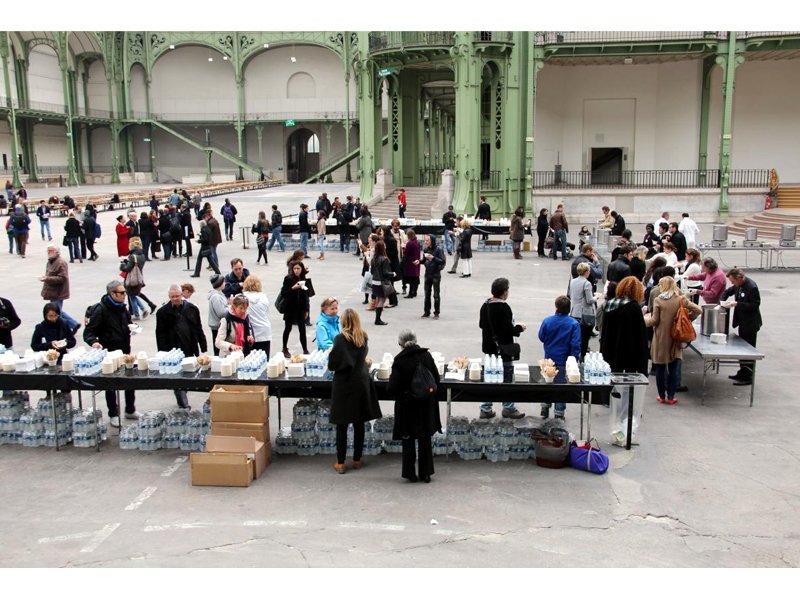
“In reaction against commodification in the art world, the relational paradigm read art in terms of its audience relations. The artist was no longer lone genius revealing higher truths beyond the everyday world. Instead, his or her role was to be a conduit for bringing people together in surprising ways. It was a dramatic move. Overnight, galleries became restaurants.”
—Kevin Murray
The question of participation has been bubbling in my mind ever since I was introduced to the work of Roseanne Bartley and Gabriel Craig in 2009, a year after I saw Yuka Oyama’s Schmuck Quickies (SQ) and, my god! were they all hot!
“Hot,” in this sentence, describes the unexpected but most welcome branching out of contemporary jewelry into the public space, and its engagement with a/the “wider public”: two things that felt both urgently necessary for insular jewelry and seemed perfectly embedded in (as opposed to perfunctorily added to) this threesome’s practices.[1]
I want to come back to it today because the notion of “participation” continues to loom large in cultural programs around the world, in all artistic fields: It ties in nicely with institutional outreach programs, finds its ways up into policy making (as a way—cynical me—to dump part of the social bill onto the artist’s lap), and into the lingo of web 2.0 users. This general, diffuse interest is my alibi: I care, because jewelers’ ventures into participation are embedded in a much larger cultural zeitgeist. This gives participatory strategies the unusual distinction of being a fringe phenomenon in a culture that has (also) embraced it. Oyama, Bartley, and Craig, once considered experimental outliers, have become role models for a generation that gets participation.
I also care because user participation is a weird beast: a capitalistic dream of unpaid labor by anonymous workers, rolled up in a social project of community empowerment, as freed from actual quantifiable results by the seal of artistic experimentation. But it also is a break away from the sovereignty of the author, his work, and signature, in favor of process-based, knowledge- and production-sharing protocols that can be extremely rewarding for participants, in ways that over-the-gallery-counter contemplation is not. This second aspect is a powerful lure for jewelers, who find in it a way to align their practices with newish art strategies, whilst reconnecting with a public that their demanding work may have left behind.

User participation is also an old beast: Art historian Claire Bishop finds a point of origin in the incendiary theatrical production of the Italian futurists, and the mass spectacles organized in Lenin’s post-revolutionary socialist republic. The next surge in participatory experiments takes place either side of the Atlantic, either side of 1970: in Latin and South America, the United States, Central and Eastern Europe. The third participatory wave, finally, seem to have been rippling across the global art world from the 90s onward, in museums and biennales.[2] Bishop details the very contradictory impulses that govern these different waves, and leaves her much-enriched reader panting for a clearer sign at the door: Is this art? Is this social practice?
The question is at the root of Bishop’s Artificial Hells, which challenged the art world’s uncritical embrace of all things participatory. Her criticism informs my own reservation with occasionally tokenistic nods toward social engagement, or user participation, where either one, like modesty panels, front the production of mediocre work. Is participation about pursuing a social agenda through art? And if so, is picking up bits of plastic waste to make necklaces the most efficient way to clean the planet, or raise awareness about sustainability? Or is it about experimenting with new forms of art, and inventing new forms of spectatorship?

In this briefing, I will be looking back at Gabriel Craig’s Reforming the Collection (2013),[3] Roseanne Bartley’s Seeding the Cloud (2010–ongoing),[4] and Yuka Oyama’s Schmuck Quickies (2002–present),[5] and trying to understand how the notion of participation intersects with contemporary craft/jewelry practice, in order to achieve three things:
• analyze the relationship between the “social” and “artistic” aspect of their practices
• parse out some differences between these three makers’ public projects
• and finally look at how they have defined a new figure of the social jeweler.
As per usual, I am not doing this in a conceptual vacuum: Aside from a couple of influential texts that I will lean on extensively in this short overview,[6] I have looked a number of AJF publications, four of which are particularly relevant:
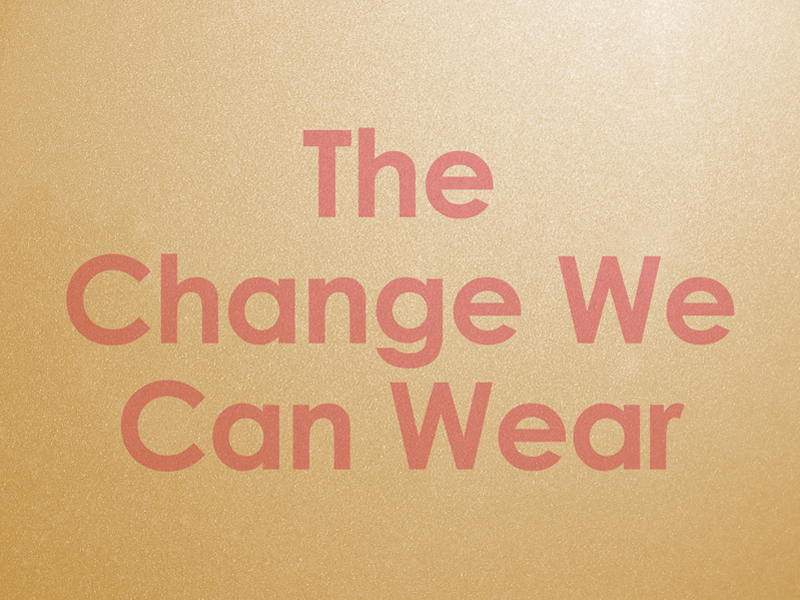
Jewelers came comparatively late to participation. My—and the field’s—early resistance to the idea of using the participatory framework in a jewelry context may have resided in the fact that craft objects and jewelry objects are participatory to begin with.[7] Jewelry involves the active engagement of anonymous people; it generates a set of actions and emotions in them; it ferments interpersonal relationships; it cements genealogical relationship (vertically), and occasionally builds community (across). But—I realize now—if you are going to call any jewelry “participatory,” then so can you describe a chocolate cake. When I receive a pair of cufflinks as a gift, that transaction does check some of the criteria of participatory art. However the relations and emotions generated by that transaction are at once more and less than a “participation”: more, because the appropriation of the object is largely self-generated (as opposed to scripted by an outside artist/referee); less, because it lacks the conventional markers that identify art social projects, and amongst them, an audience, a rendez-vous point, a stated task, its documentation, and the simple fact that the encounter has been designated as art by its organizer (and/or the institution that hosts it).
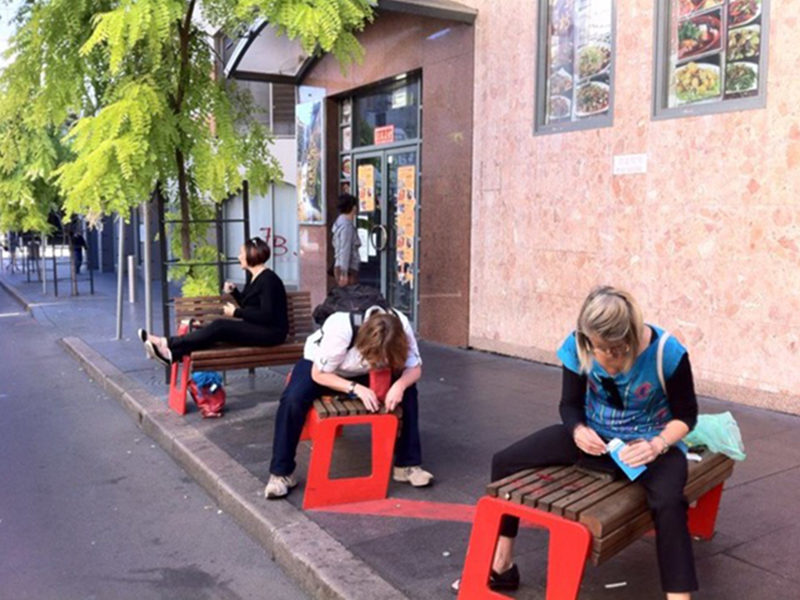
To understand how this shift in practice questions the analytical tools we otherwise use to examine jewelry, it is probably a good idea to understand why jewelry artists have embraced it.
Histories
One of the interesting contradictions in jewelers’ impulse to deal in participatory strategies is that they are less about finding users than about creating a public, and a different kind of usership: i.e., finding participants whose engagement with contemporary jewelry is at once more active, and less personal.
At the root of this expansion in jewelry, in many cases, is a desire to create encounters with different types of public, as framed by the wide range of locations chosen by the artists, and replacing a professional network by one that might be constituted by an institution (Craig), an existing social gathering point (Oyama) or an extended circle of friends (Bartley). Ours is perceived as a pretty insular field, often criticized for catering only to its own: Moving out of the workshop is a way to target new audiences.
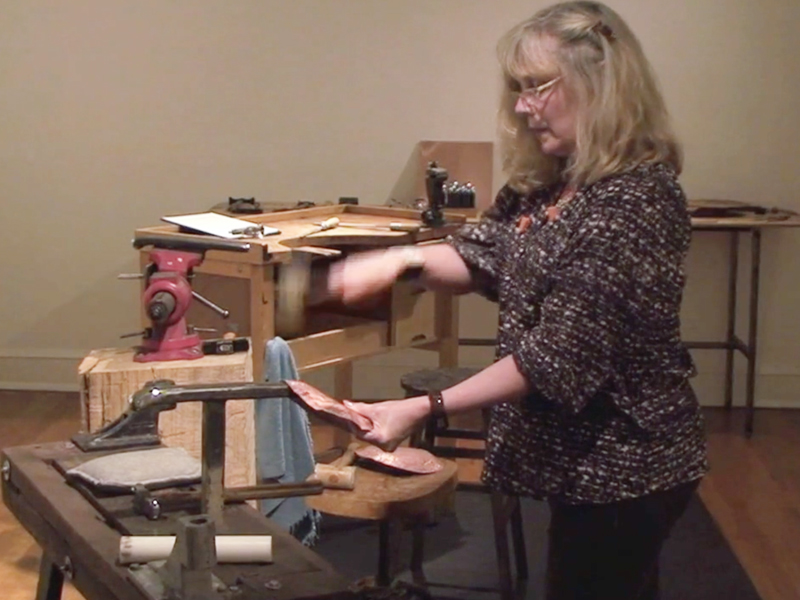
The goal of these projects (and this is a simplification) is to encourage a form of personal catharsis through a public or publicized performance.[8] This “revelation” may be about the difficulties and pleasures of shaping metal (Craig) or a political statement about sustainability, like Bartley’s Seeding the Cloud.[9] In more abstract terms, direct engagement seeks to promote a different type of usership, which implicates participants quite differently than either buying or wearing a piece of jewelry would. As Damian Skinner and Mònica Gaspar have suggested, these projects reject the question of what jewelry is, in favor of what jewelry does.[10]
Art for people not present
Paradoxically, the popularity of the three works under discussion is inversely proportional to our being present at them: I have not, and will never, experience Schmuck Quickies, the Walk, or Reforming the Museum. The tension between the projects’ easy accessibility and the fact you and I will never experience them firsthand puts us in a strange position or receivership—which to be fair, is really a readership rather than an audience. This remove is not a quality inherent to the work, but it is fundamental to my perception of it, and I could describe it this way: Somewhere, some time ago, something happened that continues to send ripples through these artists’ primary constituency—namely jewelers, who recognize in this work the participatory potential of jewelry—via documentary material.
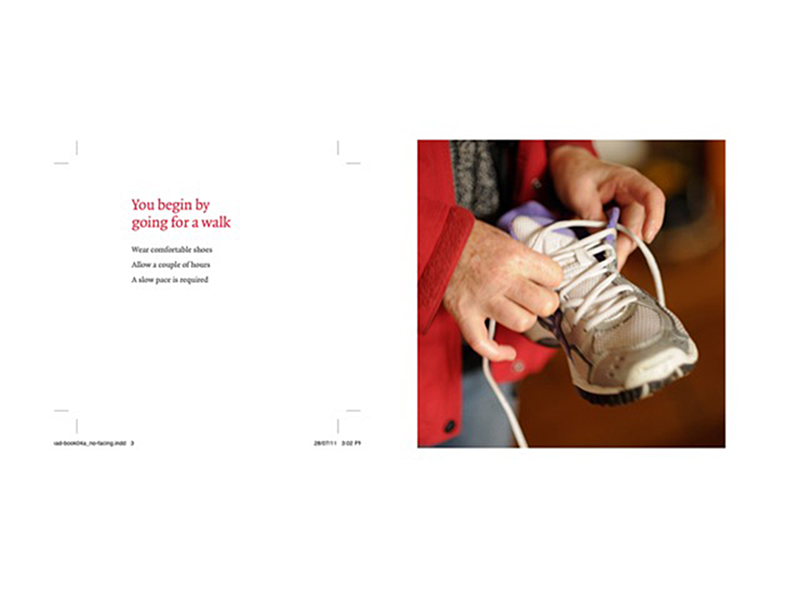
This split between primary and secondary audience may in fact help answer a few more questions about this art. My assumption—and as far as I can tell, the assumption of as great a scholar of participatory art as Bishop—has always been that the direct recipients of participatory works were the audience: that performances should therefore be analyzed within the small nexus that comprises the artist, the participants, and direct witnesses. But I am curious to see what happens if we question the idea that the people who were there were the actual recipients of these works.
Let’s start by distinguishing between primary and secondary audience: between (1) people who were present and actively engaged with the performance and (2) people who are removed from the action to the point that what they think, or do, has no effect on the event. You, me: the external witnesses. I’d like to argue that the “social” element of this work concerns the primary audience, and that its artistic aspect is constituted elsewhere, namely in its restitution, via documentation and storytelling, to an absent audience.
Acknowledging the fact that the largest part of these works’ audience is absent makes the analysis slightly less complicated. From this position, the word “participatory” does not describe something that I am experiencing, but rather something that is represented to me: in the picture of Bartley and friends bent over her bench, in the excellent photographs of Oyama’s dressed-up patrons, in the video that Craig put online. From that position, some of the concerns of social work (usefulness, pertinence, efficacy) and some of its criteria for evaluation (quality of mediation, permanence of the work’s effect on its target population) are subsumed to my own, late 20th-century criteria for understanding an artwork: Does it complicate my understanding of the world in interesting ways? Or provide an experience—aesthetical, intellectual, haptic—that is notable? Is this an art that questions its own premises? Is it bringing something relevant to the conversation on jewelry, or craft?
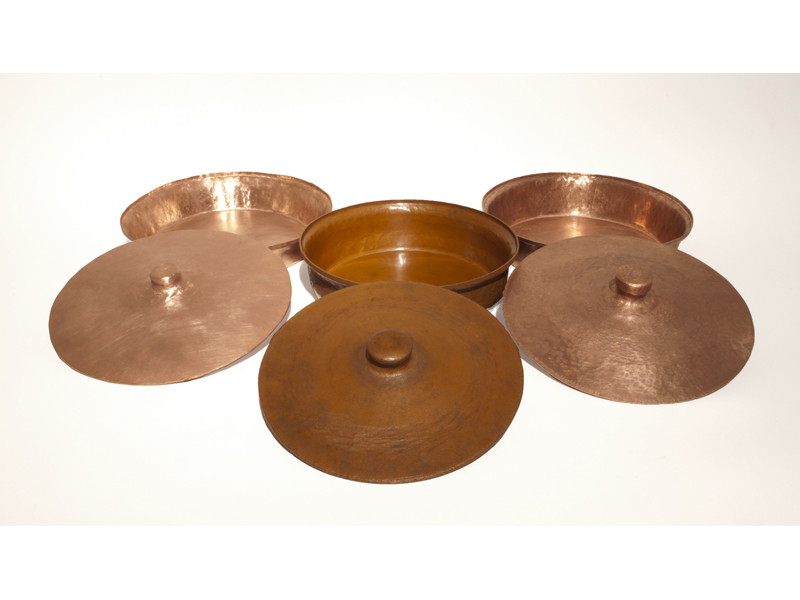
Rereading
By developing the participatory format within a craft framework, these performances are suggesting other modes of making that feel new, and quite liberating, by proposing the technicity of craft to be a matter of emotional endurance rather than making skills. Answers to my other questions are more divided. Craig’s Reforming the Museum does not complicate my understanding of the world. In the film, I very much enjoyed seeing, side by side, the three “identical” bowls without designated authors. That piqued my curiosity, and raises interesting questions about authorship and innovation. But the rest of the performance is too illustrative, and never diverts, if only for a bang, from the representation of its didactic purpose (there are no accidents, no surprises, no questions of the format of the performance itself: it merely provides evidence). The fact that it was a commission may explain this—and in particular why the audacity of either the artist’s earlier Gospel or Pro Bono are missing from it. (Giving a free piece of silver jewelry in exchange for the audience’s attention, as Craig did in Pro Bono, is so observant of the “normal” and specific transactions that surround jewelry and radically at odds with them, so new, also, in that it requalified passersby as audience-for-hire, that it ticks all of “my” boxes as a great piece of art.) In short, while it must have been a very inspiring experience for participants, and fulfilled the museum’s interest in an outreach program, it does little for me as an artistic proposition.
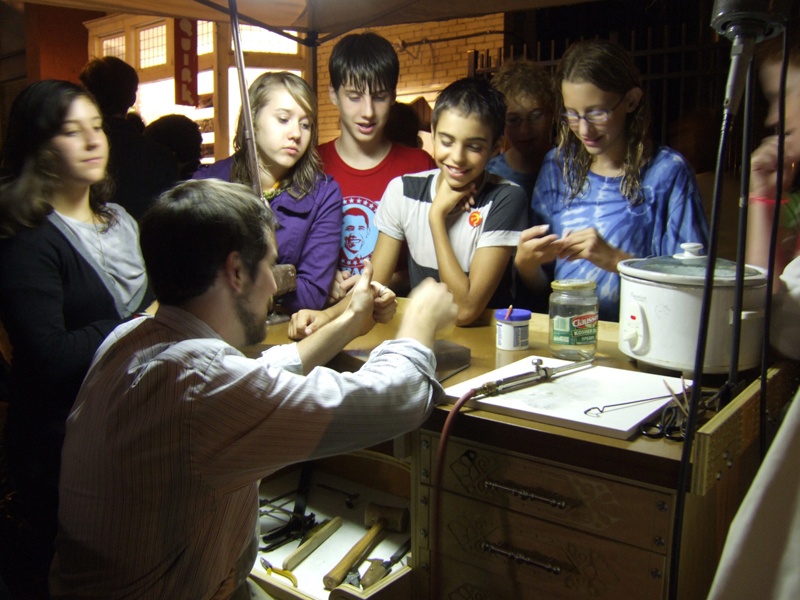
Roseanne’s Seeding the Cloud, meanwhile, does a convincing job of presenting her necklaces as a valid and coherent artistic outcome of the project. To begin with, they are commensurate to a distance: As the artist walks, so does her harvest of plastic refuse grow. This aspect sends me back to (and flips around) the Tom Thumb fairy tale. Like it, it spins a yarn that is both intensely situated and completely universal (this helped make Seeding globally relevant and appealing to people who have never been in Melbourne, where the artist lives).
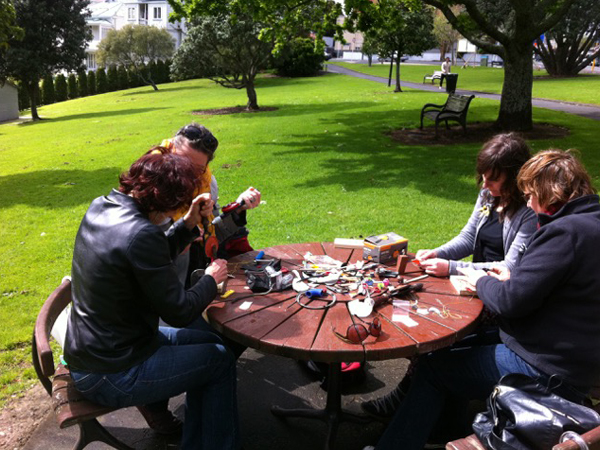
I also like that the object should derive its evocative powers from the visual overlap of commonplace pearls, and hand-picked waste. This reversal is a tease. It connects contemporary jewelry’s critique of preciousness with the very old idea of harvesting jewelry from nature’s bounty, to which it gives a missionary flavor. In short, there is a nice dialogue between the social aspect of the project, the unprepossessing objects that came out of it, and the history of jewelry. That conversation does interesting things to the author—who doubles as trainer, organizer, and host—and to jewelry—which is simultaneously a byproduct, a relic, and the document of a situation. In all this, the question of proportion is central to my appreciation of Bartley’s Seeding the Cloud: If a necklace is a ridiculously paltry remedy to waste, it does sort of nicely suggest that change, should change be on your mind, will laboriously happen at ground level, as you and I bend down to pick up our trash.
More than her two contemporaries, Oyama conceived her early social projects, including Schmuck Quickies, as an experimental setup for the creation of one-off, participant-sensitive artworks. This did not make the human context less important, or involving (she spent three months in the small rural town of Tooka-Machi to harvest material and engage with and adapt to a reserved people, and found the unexpected solution to a relational deadlock in the form of a barbecue), but she has been very clear that engagement should produce stand-alone, visual results:
“To me, SQ was never a relational aesthetic practice. I demanded the visual results, and it was never an open-end art practice.”[11]
Paradoxically, this stated goal is actually dependent on participants expressing their wishes, and letting her interpret them. From Shinichiro Takahashi: “I want to have the strongest look of all so that no one can beat me. It looks like a bug. Great! Add some more of that blue stuff. I’ve got to go to a party in town.” And Yasuhiro Wada: “I am an architect. I am pickier than any of the other guys here. Well, I would like to have something decent. Do you understand what ‛decent’ means?” This is a situation jewelers around the world know well enough, but reconfigured here to be a creative necessity, underpinning a project that is also crowdsourced, public, ephemeral, and theatrical. The remarkable photographic results, like later Oyama projects, require some suspension of disbelief: Did those people really ask for this? How did she convince them that taping a plastic tennis racket to their shirt front was a good idea—under any circumstance? What exactly is the nature of the transaction, seduction, or compassion that went on between them?[12] In short, while the social, on-the-ground aspect of SQ is a fundamental part of both the project and of my intellectual appropriation of it, that aspect survives in all its complexity in the intense, stand-alone photographic documentation that it gave birth to.
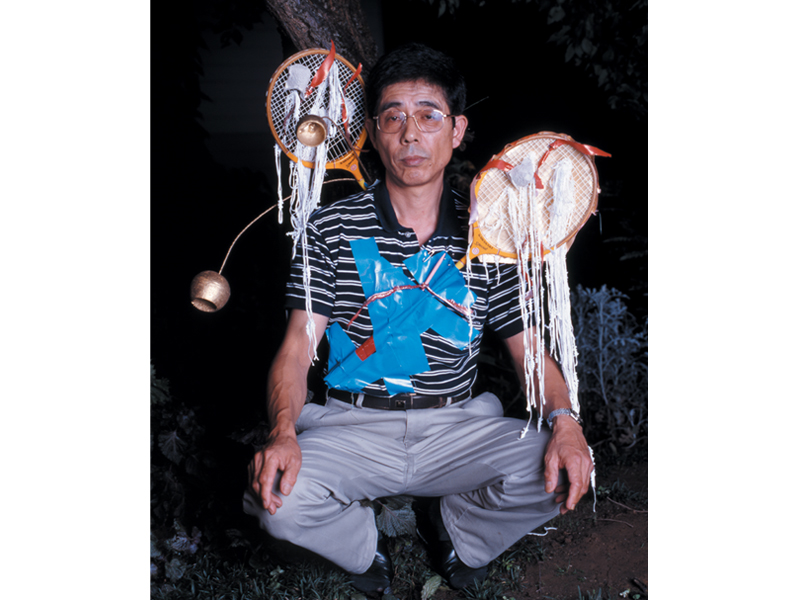
Conclusion
In the guise of a conclusion, I’d like to outline the heroic figure that these jewelers cut against their workshop-based contemporaries: How they are different from them, and why they are interesting models.
The first, and somewhat strange, byproduct of participation is that it relocates the artist within an economy of service: No longer the producer of goods, she is an initiator, organizer, and promoter of scenarios for public encounters. For the project to work, she must ensure that the modes of participation, the implementation, and the results of the projects circulate online and off-line—following in that sense the entropic model of participatory art since its inception: A public event taking place out of (our) sight re-enters the art world through its documentation. (Craig says about his own projects that it is “rare [for me] to develop a project independent of the mechanism that would distribute it.”[13])
The second notable aspect of this practice is that it overwhelmingly inhabits the public space (whether institutional or not): Not even the translation from primary to second audience—from the event itself into images, films, or books—seems to find a way into a market. There is little, or nothing, to sell. This increases these artists’ dependence on institutions that are more interested in knowledge than objects—museums and academia—and that, in turn, is encouraging artists with hybrid practices to become their own subjects of study, and become residents of these institutions.
Which is where this all becomes a little schizophrenic. These makers’ “participatory turn” seems to have been followed by an “academic turn”: Oyama and Bartley are both currently working on producing the theoretical instruments to analyze and evaluate their own work,[14] while Craig has long ago become a consummate analyst of his own practice.
While I worry that intense intellectualization will shift the element of “proof” away from the public into the hands of academic bodies, I do know that artists who choose this path are incubating within academia ideas that will continue to develop outside of it. But as I write these lines, I also wonder about the larger implications of channeling creative endeavors toward self-observation, and what a bureaucratic culture premised on scientific arguments—should PhDs by project become the norm in our field—will do to the next generation of intrepid social jewelers.

[1] Consistency in practice and diversity are the main reasons I chose these three examples as my case studies. There are numerous other strategies for engaging with the public, or users: often, but not always on the street. These strategies, which were marginal until the late 10s, are now quite popular in Australia and New Zealand (Jacqui Chan, Caz Guiney, Sarah Read, and Renée Bevan, for example, but also Subliminal Infiltration and Vivien Atkinson). Their practices—between social project and performance—deploy themselves in the public space, and mobilize the hands of more or less improvised collaborators. In Europe, Bòrax08001, Moving On Collective, Makers Move, and MAD have all staged attempts at collective infiltration of the public space. In their simpler format, street actions (or parades) have become a mainstream way of showing work to a wide(r) public. Some aspects of these projects can be, at times, participatory.
[2] This timeline directly follows Claire Bishop’s second book about participation in art, Artificial Hells (London: Verso, 2012). In it, she suggests that it is no coincidence that revolutionary dates—1917, 1968, and 1989—coincide with surges in participative interests.
[3] Reforming the Collection “engag[ed] visitors to the museum in creating a derivative work. Over the course of the exhibition Gabriel Craig created scale drawings, a video and a photographic record of the performative work in addition to the creation of two lidded copper bowls. One created by the artist and one created by the cumulative efforts of 46 visitors to the museum over the course of a week.” (From the presentation of the project on vimeo: https://vimeo.com/68954358.)
The implicit method of the project was to instill a sensitivity to the challenges and rewards of hand-making through visitors’ partial immersion into a makeshift studio. Documentation shows a wide demographic laboring over raising stakes alongside the artist. The fact that Craig is referred to as “the artist” raises the usual authorship issues surrounding participatory work: If he is an “artist,” then one must assume that the action taking place in the museum is a form of art (as opposed to a demonstration, or a tutorial), and that visitors are both the recipients of, and material for, this art.
The art-making narrative is further complicated by the fact that both Craig and the 46 participants are in fact copying someone else’s work (a bowl by Kazuma Oshita). This aligns with participatory strategies’ historical emphasis on process over product, and the attendant shift of this art’s domain of application—from the object being made, to the setup devised by the artist.
[4] Seeding the Cloud, a deambulatory project, involves a form of “surface archeology,” namely, in this case, the harvesting of plastic waste from urban areas, which is transformed into necklaces on the fly. (Quote from the artist’s website, https://roseannebartley.wordpress.com). Bartley has fashioned a DIY rig that accompanies her—and those who come with her—and allows them to fabricate necklaces in situ. See her from afar busy drilling through plastic bits over a park bench, and you’ll probably think she is making a (complicated) sandwich.
[5] Oyama initiated her Schmuck Quickies project in 2002. This consisted of public performances (in- or outdoors), during which the artist would make on-the-spot jewelry for passersby in response to the simple question: “What kind of jewelry shall I make you?” She used donated material that tended to reflect the culture of the region, and operated with the help of volunteers, from a nomadic workstation. (the performance was held in Germany, Austria, Japan, England, Australia, Switzerland, and Italy, and is still ongoing). The jewelry usually consisted of loud assemblages of fabric and recycled objects, taped or stitched together and on the participant’s clothing, which live on through their photographic documentation—Polaroids of people briefly transformed into their own fragile totemic alter egos.
[6] Two texts, in particular, inform my thinking: Claire Bishop’s Participation (Cambridge and London: the MIT Press, 2006) and Artificial Hells (London: Verso, 2012).
[7] This point of view is echoed by Damian Skinner and Mònica Gaspar, although they take it somewhere else: “Jewelry is a category of object that has always been relational in nature,” in Mònica Gaspar and Damian Skinner, After Wearing: A History of Gestures, Actions and Jewelry (Pratt: New York City, 2015), 4.
[8] This “activation” supposes the user/recipient to be a passive agent and seeks to empower him. It reflects the human fear that individuals are unable to find agency in a world that is seemingly increasingly attentive to the representation of individual freedom (of choice, of action) but leaves extremely little space for it. Its stereotypical targets are the couch potato, the uncritical consumer, the dumb, brainwashed victim of capitalist uniformization.
[9] It then reflects a third issue that participative strategies sometimes hope to remedy: a perceived crisis in community and collective responsibility.
[10] Gaspar and Skinner, After Wearing, 4.
[11] Yuka Oyama in email to author, May 22, 2016.
[12] Recent conversations with the artist make me think that she had already begun to channel ornamentation and costume toward cathartic effects. This led her, later on, to isolate her subjects from her audience, and create intense scenarios of reenactments and mise-en-scene, as now completely separated from accidental onlookers. She did so in Collectors (2013), where object wearing is secondary to the photographic representation of mania, or in Stubborn Object Psycho Drama (2016), a 13-minute video in which a group of strangers enact a drama scripted spontaneously in reaction to wearing object-morphic “suits.” Those later works make it an easy job to understand the difference between “participants” and “audience”: We know where things are, and where we stand.
[13] Gabriel Craig, during a Face 2 Face discussion (with Sam Aquillano and Jason Talbott, moderated by Anna Walker), May 22, 2015, SNAG Boston
[14] At the time of writing, Bartley has enrolled in a PhD at the School of Architecture and Design RMIT. Oyama, meanwhile, will finish a three-year research fellowship at the Oslo National Academy of Arts, Art and Craft. Unsurprisingly, her academic tutors come from various disciplines: fine art (Sunniva McAlinden, Jennifer Allen, and Olaf Gislasson), choreography/costume/scenography (Karen Kipphoff and Christine Lindgren), theater (Karmenlara Ely), public art (Per Gunnar Tverbakk), ethnology of material culture (Dr.Hans Peter Hahn) and craft (Jorunn Veiteberg).





